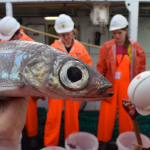Life in the Mesopelagic

The mesopelagic - or ocean twilight zone - is the dimly lit part of the ocean between the productive surface waters and the deep-sea. It is among the largest but also least explored and understood ecoystems of the planet. This vast midwater habitat is inhabited by fish, squid, jellyfish and zooplankton. Their ubiquitous presence is revealed by acoustic deep scattering layers found across all oceans.
Mesopelagic fish stocks are the largest and least exploited in the world, with a global biomass on the order of 1,000 to 10,000 million tons, maybe 10-20 times that of all other fishes combined. Many organisms in the mesopelagic rise to the surface at nighttime to feed, before migrating back to great depth before the sun returns. Therefore, mesopelagic organisms play an influential role in oceanic food webs, carbon sequestration, and biogeochemical cycling. There is also renewed interest in their commercial exploitation as feeds or food for human consumption.
Large knowledge gaps on these organisms and their role in and interactions with other parts of the marine ecosystem and global climate remain. Specifically, How much mesopelagic biomass is there and how to accurately estimate it? What controls species composition, population structure and distribution of mesopelagic communities? What is the importance of mesopelagic organisms in the diet of oceanic top predators and commercial fish stocks? What is the fraction of migrators and what controls their migration? What are the consequences of de-oxygenation and implications of harvesting of midwater organisms? How do migrating mesopelagic fishes shape pelagic ecosystems through top-down control and food-web cascades? We often also lack fundamental biological information e.g., physiological measurements of vital rates but also studies of life histories and behaviours are sparse.
Jump to section:
- Long-term research focus - Light, Vision, and Ecosystem Dynamics
- Ongoing work and emerging questions
- Mesopelagic fish models
- Early work - the mesopelagic on our doorstep
- Group members involved in mesopelagic research
Long-term research focus - Light, Vision, and Ecosystem Dynamics
From the outset, our research has focused on the role of light and visual foraging interactions in shaping behaviors, distributions, and life histories. While many research groups in visual ecology concentrate on the design and evolution of eyes, their specialization for specific tasks, and their integration with other senses for signaling, navigation, and prey detection, our work stands out for its emphasis on how light, through vision, influences ecosystem dynamics via top-down control. Our research spans ecosystems from the Arctic to the Mediterranean, the Red Sea, and the Southern Ocean, linking physics to biology by integrating field observations with detailed modeling studies.
Mesopelagic fish traits: Functions and trade-offs
Fish and Fisheries. 26: 83-103. [ doi:10.1111/faf.12867 ] [ open access ] [ pdf ]
Model of mesopelagic fish predation on eggs and larvae shows benefits of tuna spawning under full moon
Limnology and Oceanography. 68: 2632-2641. [ doi:10.1002/lno.12465 ] [ open access ] [ pdf ]
Poleward distribution of mesopelagic fishes is constrained by seasonality in light
Global Ecology and Biogeography. 31: 546-561. [ doi:10.1111/geb.13446 ] [ open access ] [ pdf ]
and some of our "classics":
Efficient trawl avoidance by mesopelagic fishes causes large underestimation of their biomass
Marine Ecology-Progress Series. 456: 1-6. [ doi:10.3354/meps09785 ] [ open access ] [ pdf ] [ feature article ]
Enlightening the ocean’s twilight zone
ICES Journal of Marine Science. 76: 803-812. [ doi:10.1093/icesjms/fsz010 ] [ open access ] [ pdf ]
Light penetration structures the deep acoustic scattering layers in the global ocean
Science Advances. 3. [ doi:10.1126/sciadv.1602468 ] [ open access ] [ pdf ]
Ongoing work and emerging questions
Mesopelagic food-web cascades and their impact on ecosystem structure and predictive modeling
While several of our previous studies have explored how light penetration affects mesopelagic fish, we have recently become interested in how mesopelagic fish might affect light penetration through food-web cascades. Simulations with idealized microbial food-web models demonstrate that euphotic zone properties are strongly affected by migrating mesopelagic fishes. The emergent hypothesis is that strong predatory impact on mesozooplankton by mesopelagic fishes causes food-web cascades involving a diatom nutrient trap. This trap, being located at the bottom of the euphotic zone, controls the amount of nutrients available to the organisms of the upper euphotic zone. Although such food-web cascades might not be very pronounced in nature, they are very pronounced in models and demand far more attention in ecosystem and climate modeling.
Effects of migrating mesopelagic fishes on the biological carbon pump
Marine Ecology Progress Series. 717: 107-126. [ doi:10.3354/meps14373 ] [ open access ] [ pdf ]
Advection and trophic subsidies
Mesopelagic ecosystems have been primarily studied for their vertical connections between surface waters and the deep sea, focusing on sinking particles and vertical migration. Small mesopelagic fishes may account for up to 95% of the global fish biomass. What happens to these organisms as they drift with the currents, and how and where does this biomass enter the food chain? What is the role of ocean currents in driving source-sink dynamics in mesopelagic fish? We hypothesize that advection transforms ocean currents into food conveyor belts, transporting prey from the open ocean to subsidize local production in shelf seas on a much larger scale than currently acknowledged.
Light limits distributions at high latitudes
Diel vertical migration, exhibited by many mesopelagic organisms including fishes, is an adaptive behavior evolved under a regular light cycle to avoid detection by visual predators in sunlit surface waters. However, this "hide and seek" strategy becomes challenging at higher latitudes where the light cycle is more extreme. During the midnight sun, zooplankton prey is abundant in surface waters, but it is never safe for mesopelagic migrants to ascend due to constant daylight. Conversely, during the polar night, the twilight zone extends to surface waters around the clock, but most copepod prey are in diapause at great depths, where it is too dark even for mesopelagic fish to detect them. As a result, seasonality in the diel light cycle emerges as a major constraint on the distribution of mesopelagic fishes at high latitudes in our models. What does the absence of an otherwise ubiquitous zooplanktivore mean for the ecosystem structure and function at high latitudes?
Poleward distribution of mesopelagic fishes is constrained by seasonality in light
Global Ecology and Biogeography. 31: 546-561. [ doi:10.1111/geb.13446 ] [ open access ] [ pdf ]
Light and energetics at seasonal extremes limit poleward range shifts
Nature Climate Change. 11: 530-536. [ doi:10.1038/s41558-021-01045-2 ] [ Video abstract ] [ Read for free on Nature website ]
Mesopelagic fish models
Over the years, we have developed several models predicting mesopelagic fish behavior and the ensuing fitness consequences. Here are a few examples:
Light comfort zone in a mesopelagic fish emerges from adaptive behaviour along a latitudinal gradient
Marine Ecology Progress Series. 623: 161-174. [ doi:10.3354/meps13024 ] [ open access ] [ pdf ] [ Online supplement ]
Herding mesopelagic fish by light
Marine Ecology Progress Series. 625: 225-231. [ doi:10.3354/meps13079 ] [ open access ] [ pdf ]
Early work - the mesopelagic on our doorstep
The Theoretical Ecology Group has been studying mesopelagic ecosystems since the 1980s. Initially, our research focused on the fjord environments near Bergen. Many of the insights that inform our work today were gained during these early efforts observing and modeling the mesopelagic environment using fjords as model systems.
Winter distribution of macroplankton and micronekton in Masfjorden, western Norway
Marine Ecology-Progress Series. 45: 45-55. [ doi:10.3354/meps045045 ] [ open access ] [ pdf ]
Significance of advection for the carrying capacities of fjord populations
Marine Ecology-Progress Series. 50: 263-274. [ doi:10.3354/meps050263 ] [ open access ] [ pdf ]
Vertical distribution and trophic interactions of zooplankton and fish in Masfjorden, Norway
Sarsia. 75: 65-81. [ pdf ]
News
 Mohn Starting Grant for TEG researcher Tom Langbehn
Mohn Starting Grant for TEG researcher Tom Langbehn
Congratulations to Tom Langbehn on receiving the prestigious Starting Grant from the Trond Mohn Research Foundation! His project aims to uncover the mechanisms that determine when and where prey from the open ocean becomes accessible to predators.
[9 December 2024]
 Tom Langbehn Gave Early Career Keynote at ICES Annual Science Conference
Tom Langbehn Gave Early Career Keynote at ICES Annual Science Conference
Tom Langbehn gave the Early Career Keynote at the 2024 ICES Annual Science Conference in Gateshead, UK, at the end of September. The recorded talk has now been made available online by ICES.
[3 October 2024]
 TEG hosts a two-day international workshop on Light as a Driver in Marine Ecology
TEG hosts a two-day international workshop on Light as a Driver in Marine Ecology
As our four-year project on the fundamental role of mesopelagic fishes in the structure and change of Northeast Atlantic marine ecosystems comes to an end, and with Dag Aksnes retiring from his formal duties at the university, we found a perfect opportunity to host an international workshop on Light as a Driver in Marine Ecology.
[23 September 2024]
 Mesopelagic Session at the ICES Annual Science Conference
Mesopelagic Session at the ICES Annual Science Conference
Tom Langbehn is chairing a session on Biomass, biodiversity, and ecosystem services in the mesopelagic zone at the ICES Annual Science Conference in Copenhagen in September.
[21 January 2020]
 Fish Repulsed and Attracted by Artificial Light
Fish Repulsed and Attracted by Artificial Light
A recently accepted article in Marine Ecology progress Series by Stein Kaartvedt, Anders Røstad, Anders F. Opdal, and Dag L. Aksnes shows how a diving ROV with an attached light source trigger dichotomous responses in the mesopelagic fish assemblage.
[17 August 2019]
Mesopelagics team
 Tom J. Langbehn
Tom J. LangbehnResearcher
I am a quantitative ecologist, or "ocean-going modeller," with a broad interest in global change ecology, evolution, and sustainable fisheries. My primary focus lies in the pelagic ecology of high-latitude oceans and the ocean twilight zone, aiming to understand the mechanisms that link individual behaviours, interactions, and life histories of zooplankton and fishes to large-scale patterns in the environment.
 Christian Jørgensen
Christian JørgensenProfessor (Group Leader)
I work with adaptation as a tool to build models that scale mechanisms at the individual level to population-level patterns and evolutionary outcomes. Topics of interest include mating systems, fishing-induced evolution, life history theory, and algorithms for modelling evolution.
 Gabriella Ljungström
Gabriella LjungströmResearcher
I am an evolutionary ecologist with an interest in global change ecology. My research has mainly focused on understanding how environmental changes, and particularly climate change, affect animals that live in seasonal environments. I also have a strong interest in sustainable use of marine resources and work on several topics relevant to the Sustainable Development Goals.
 Anders F. Opdal
Anders F. OpdalResearcher
I am currently very interested in the field of life history evolution, and often find myself somewhere in the interface between long-term data series and theoretical modelling.
 Øyvind Fiksen
Øyvind FiksenProfessor
I am particularly interested in behaviour and life-history of marine organisms, and how traits emerge in populations and ecosystems through natural selection.
 Jarl Giske
Jarl GiskeProfessor
My main research interest is to model how animals make decisions. Currently I study the proximate architecture for decision-making in animals and the implications of this architecture on individual behaviour and on phenotypic and genetic diversity in populations.
 Dag L. Aksnes
Dag L. AksnesProfessor Emeritus
Two of my current research questions are about mesopelagic fishes and their potential role in carbon sequestration and about effects of increased terrestrial greening on marine ecosystems. I am also engaged in science advise on how to achieve more sustainable food and feed production.
 Stein Kaartvedt
Stein KaartvedtGuest Researcher (Professor Emeritus at University of Oslo)
My interest is pelagic ecology, and how environment, predators, and prey together affect abundance, distribution, and behaviour of zooplankton and fishes.



